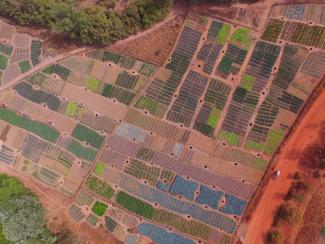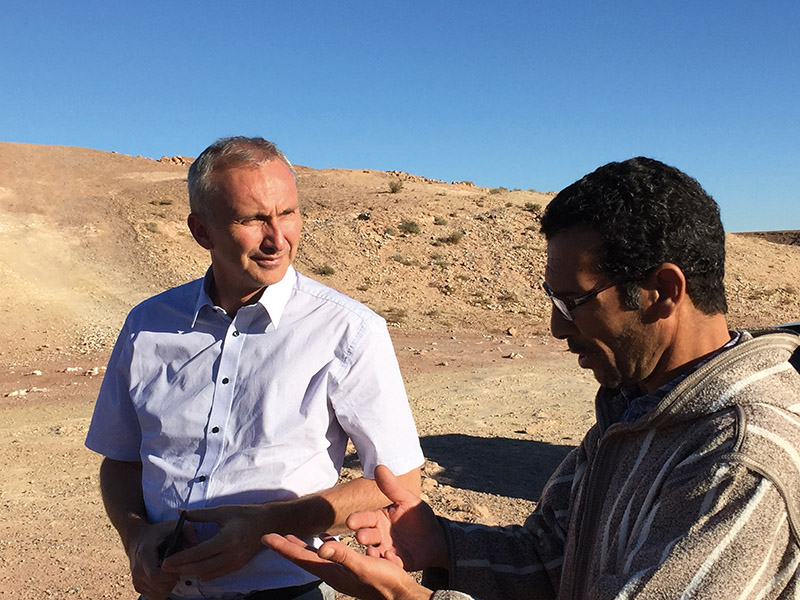Technical solutions
Remote project management is helpful in times of crisis

Since the crisis began in March 2020, KfW’s work in partner countries has become more difficult. On site monitoring is only possible to a limited extent. At the same time, the pandemic and its impacts have increased the need for international support. It has therefore become more urgent than ever to scale up ongoing projects as well as to launch new ones.
Normally, KfW project managers travel to partner countries regularly, discuss with the people involved in a project, develop new projects or check whether projects are proceeding according to plan. Partially this can be done in capital cities or regional centres, particularly with regard to measures in the financial sector or national governments’ reform financing.
A core task of development cooperation is expanding and rebuilding infrastructure. When it comes to projects like the construction of streets, schools, hospitals, granaries and water pipelines, KfW normally monitors progress directly onsite. KfW experts repeatedly visit the partner country to ensure that plans are being carried out successfully and achieve the desired impact. To some extent, these findings are based on random sampling. The pandemic, however, has upended this routine.
Long before the Covid-19 crisis, KfW has built up experience in regions where onsite checks were not possible for some time. The reason then was not Corona virus, however. Travelling to the hinterland has often been too dangerous, for example in Afghanistan and Pakistan, but also in parts of Africa.
From a European perspective, the Sahel is a strategically important region, but potential instability haunts countries like Mali, Burkina Faso, Niger and Chad. Therefore, Germany’s federal government is pursuing the goals of pacifying and stabilising critical countries and creating development prospects for their people. Development cooperation strongly contributes to this process.
Remote management
Ever more often, however, KfW supports projects in this region from afar due to the tense security situation. The bank relies on remote management, monitoring and verification (RMMV). Technology is helpful of course. Photos taken from satellites, airplanes or drones, geo-referenced databases and digital applications for project management are essential.
Nonetheless, local staff of KfW in the partner country are still very important. They are either citizens of the country concerned or expat consultants who still have access to the project region. They have increasingly become “eyes and ears” of KfW onsite. Both visual and audio information is relevant. Online dialogue, image transmission and virtual-reality applications have become indispensable.
Mali, for example
In northern Mali, KfW is primarily monitoring projects by remote means, because violent unrest is common. Though areas along the Niger river are well-suited to agriculture, only about 20 % of an estimated 2.2 million hectares is cultivated. With appropriate irrigation, the cultivated area could be increased many times over. Small perimeters (demarcated areas), reservoirs, pumps, canals, wells and measures to prevent erosion could make a big impact. To tap the potential even in adverse circumstances, KfW is managing its irrigation programmes there from afar.
Drones are useful for monitoring smaller areas with a radius of a few square kilometres. The devices are battery-operated and directly connected to a computer of the implementation consultant on site. The picture material can then be further processed and passed on by phone. The images are so clear that it is easy to identify details of individual buildings. Differences from previous pictures become clearly visible
Satellite images are used as well. They are well-suited to observe larger areas. They help to answer questions like:
- Has the cultivated area grown overall?
- Has erosion occurred?
- Have canals been built or perimeters established?
Satellite imaging even helps to distinguish between individual crop species, such as maize, rice or vegetables. Pictures taken by satellite can be obtained – generally for a fee – from the owner of data rights. KfW uses satellite imagery mostly for targeted comparisons over long intervals and in fixed cycles.
The limits of technical solutions
In West Africa, some 50 KfW projects are already underway in which remote management methods are being used. Previous experience shows that in specific circumstances they can be a substitute for onsite inspections. There are limits however. A downside, for instance, is that contact with the target group and responsible parties is lost. In-person monitoring typically means that project experts talk to beneficiaries, asking parents whether they are truly satisfied with a new school, for example, or visiting local farmers and checking whether a scheme is really working.
Project experts thus gather impressions to the left and right of the beaten path. Their insights are unfiltered and often go beyond the standard mandate. Remote monitoring does not facilitate that. Perceptions remain limited, despite excellent high-resolution imagery.
There are further limitations. In order to work well over the longer term, approaches must fit the situation used onsite. Ensuring that costs money. Moreover, partners in the target countries have to be brought on board, trained and made familiar with the procedures. For these reasons, remote management often saves neither time nor money. It is frequently wrong to believe that simply avoiding travel saves money. Follow-up expenses are often incurred elsewhere.
Technological opportunities
Once innovative monitoring systems are in place, however, they can make work noticeably easier, facilitating infrastructure projects in areas where development cooperation would otherwise not be possible.
Therefore, remote management has proven useful even in “normal” times. That is particularly so when a programme consists of small-scale interventions spread over many locations. A single visit will allow a KfW expert to monitor the construction of a hospital with comparative ease and efficiency. Things are more difficult when it comes to many small infrastructure projects that are dispersed over an entire area or even an entire country.
Whereas project experts had to make do with random samples in the past, nowadays high-tech applications make more extensive reviews possible. Larger areas, like cultivated fields, a nature reserve or a forest belt, are also easier to cover and assess than before. The same is true for the evaluation of projects once they are completed.
Jochen Harnisch is KfW head of division for agriculture, water and biodiversity for West Africa.
jochen.harnisch@kfw.de
Meinhard Rögner is technical expert for the water sector in the KfW’s West Africa department.
meinhard.roegner@kfw.de











